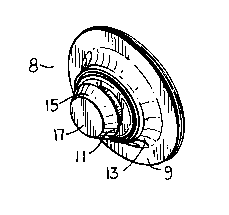Some of the information on this Web page has been provided by external sources. The Government of Canada is not responsible for the accuracy, reliability or currency of the information supplied by external sources. Users wishing to rely upon this information should consult directly with the source of the information. Content provided by external sources is not subject to official languages, privacy and accessibility requirements.
Any discrepancies in the text and image of the Claims and Abstract are due to differing posting times. Text of the Claims and Abstract are posted:
| (12) Patent: | (11) CA 2084828 |
|---|---|
| (54) English Title: | FASTENER |
| (54) French Title: | DISPOSITIF DE FIXATION |
| Status: | Expired and beyond the Period of Reversal |
| (51) International Patent Classification (IPC): |
|
|---|---|
| (72) Inventors : |
|
| (73) Owners : |
|
| (71) Applicants : |
|
| (74) Agent: | SMART & BIGGAR LP |
| (74) Associate agent: | |
| (45) Issued: | 1996-07-09 |
| (22) Filed Date: | 1992-12-08 |
| (41) Open to Public Inspection: | 1994-06-09 |
| Examination requested: | 1992-12-08 |
| Availability of licence: | N/A |
| Dedicated to the Public: | N/A |
| (25) Language of filing: | English |
| Patent Cooperation Treaty (PCT): | No |
|---|
| (30) Application Priority Data: | None |
|---|
A fastener for securing a hard shell and a soft
lining together, with particular utility for protective sports
gear, is described. The fastener has a broad flexible base
portion, a bell-shaped portion leading from the base portion
to a shoulder portion, and a post projecting from the shoulder
portion and having an annular flange extending therefrom. The
shell is trapped between the shoulder portion and the annular
flange, and the lining is trapped between the hard shell and
the base portion.
Note: Claims are shown in the official language in which they were submitted.
Note: Descriptions are shown in the official language in which they were submitted.

2024-08-01:As part of the Next Generation Patents (NGP) transition, the Canadian Patents Database (CPD) now contains a more detailed Event History, which replicates the Event Log of our new back-office solution.
Please note that "Inactive:" events refers to events no longer in use in our new back-office solution.
For a clearer understanding of the status of the application/patent presented on this page, the site Disclaimer , as well as the definitions for Patent , Event History , Maintenance Fee and Payment History should be consulted.
| Description | Date |
|---|---|
| Time Limit for Reversal Expired | 2002-12-09 |
| Letter Sent | 2001-12-10 |
| Grant by Issuance | 1996-07-09 |
| Application Published (Open to Public Inspection) | 1994-06-09 |
| All Requirements for Examination Determined Compliant | 1992-12-08 |
| Request for Examination Requirements Determined Compliant | 1992-12-08 |
There is no abandonment history.
| Fee Type | Anniversary Year | Due Date | Paid Date |
|---|---|---|---|
| MF (patent, 5th anniv.) - standard | 1997-12-08 | 1997-10-17 | |
| MF (patent, 6th anniv.) - standard | 1998-12-08 | 1998-12-08 | |
| MF (patent, 7th anniv.) - standard | 1999-12-08 | 1999-12-07 | |
| MF (patent, 8th anniv.) - standard | 2000-12-08 | 2000-10-11 |
Note: Records showing the ownership history in alphabetical order.
| Current Owners on Record |
|---|
| CANSTAR SPORTS GROUP INC. |
| Past Owners on Record |
|---|
| DANIEL CHARTRAND |
| RENE BOURQUE |
| RODRIGUE MCDUFF |